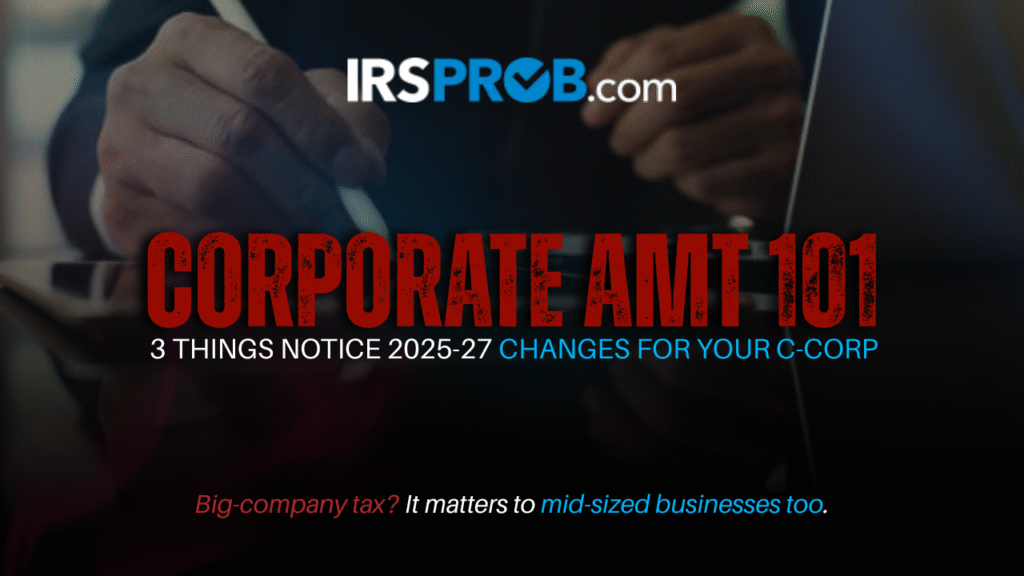
Big-company tax? It matters to mid-sized businesses too. When you hear "corporate alternative minimum tax," you probably think: That's not my problem. I'm not a Fortune 500 company. But here's the reality check.
If your C-corporation is growing, you're closer to the corporate AMT radar than you think. And with the IRS releasing Notice 2025-27 in June 2025, the rules just shifted in ways that could mean relief now and vigilance later.
Whether you're running a mid-sized manufacturer, a private equity backed company, or a rapidly scaling tech firm, this isn't abstract tax theory. This is about understanding when federal tax law says you've crossed from "regular taxpayer" to "applicable corporation" and what that label means for your bottom line.
What Exactly Is the Corporate AMT?
Corporate Alternative Minimum Tax (AMT)
Think of the corporate AMT as the IRS's insurance policy against profitable companies paying little to no federal tax.
Created under the Inflation Reduction Act of 2022, the corporate alternative minimum tax imposes a 15% minimum tax on the financial statement income of large corporations. Not your taxable income, your book income, the numbers you report to shareholders and investors on audited financial statements.
The logic? Some highly profitable companies were using legitimate deductions, credits, and timing differences to dramatically reduce their regular tax bills. Congress decided that if you're reporting massive profits to Wall Street, you should pay at least 15% to Uncle Sam, regardless of what your tax return says.
For taxable years beginning after December 31, 2022, this parallel tax system kicked in. And it's not just a theoretical concern. Treasury estimates that about 100 of the largest U.S. corporations pay corporate AMT annually, but hundreds more are within striking distance of the threshold.
Understanding "Applicable Corporation" Status
Here's where it gets personal for growing businesses.
You become an "applicable corporation" subject to corporate AMT when your three-year average annual adjusted financial statement income (AFSI) exceeds $1 billion. For U.S. companies that are part of foreign-parented multinational groups, there's a two-part test: the overall group must exceed $1 billion in AFSI, and the domestic operations must average at least $100 million.
The "Sticky" Designation: Once you're classified as an applicable corporation, you stay one unless you can prove five consecutive years of falling below the threshold or experience a change in ownership.
It's not a year-by-year test once you're in. You're locked in. This "sticky" designation means growing companies need to think strategically about when they might cross the threshold, not just react after they've already triggered it.
What Notice 2025-27 Actually Changes
1. The Simplified Method Threshold Just Got More Generous
The biggest news? Notice 2025-27 introduces an optional interim simplified method that raises the safe harbor threshold significantly.
Under this new guidance, corporations can use a streamlined calculation with thresholds of $800 million for the general AFSI test and $80 million for foreign-parented groups. That's a jump from the $500 million and $50 million thresholds in the Biden Administration's proposed regulations released just nine months earlier.
What does this mean in practice? If your corporation's simplified AFSI calculation falls below $800 million (or $80 million for the FPMG test), you're not an applicable corporation. You don't need to file Form 4626 (the corporate AMT form), and you can breathe easier knowing you're below the radar.
This simplified method uses fewer adjustments to financial statement income, making the calculation less burdensome. Instead of wading through every complex AFSI adjustment, you apply only specific adjustments related to related-party transactions, covered taxes, federal and foreign income taxes, certain tax credits, and tax-exempt entities.
Key Benefit: For companies with AFSI between $500 million and $800 million, this is huge. You just got compliance relief without changing anything about your business operations.
2. Penalty Relief for Estimated Tax Payments
Here's relief you can use immediately.
Notice 2025-27 waives the penalty for underpayment of estimated tax specifically related to corporate AMT liability for taxable years beginning after December 31, 2024, and before January 1, 2026.
Why does this matter? Corporate AMT calculations are complex and evolving. Even sophisticated tax departments struggle to accurately project CAMT liability for quarterly estimated payments. The IRS recognizes this reality and is providing a grace period.
Important Note: This doesn't give you a pass on underpaying your regular corporate income tax. But for the corporate AMT portion? You won't face penalties if you underestimate during 2025.
For applicable corporations still figuring out CAMT calculations, this removes a significant compliance anxiety and potential cash flow hit from surprise penalties.
3. The Path Forward: More Changes Coming
Proposed regulations aren't the final word. The IRS explicitly states that Treasury intends to issue new proposed regulations incorporating rules similar to this interim simplified method, along with other revisions.
Translation? The rules are still evolving. The $800 million threshold might change. The adjustments required might expand or contract. What you can rely on today for your 2024 and 2025 returns may look different by the time final regulations arrive.
What Growing C-Corps Should Watch
Let me be direct: if you're nowhere near $500 million in book income, corporate AMT isn't your immediate concern. Focus on running your business.
But if you're in the $200 million to $700 million range and growing? Pay attention.
Corporate AMT Monitoring Checklist
- Track Your Three-Year Average: Corporate AMT isn't about one blockbuster year. It's about your rolling three-year average AFSI. A single acquisition, massive contract win, or sale of a division could push your average over the edge even if your "normal" operations wouldn't trigger the tax.
- Remember: Once In, Staying In: That five-year lookback to exit applicable corporation status means you can't simply dip below the threshold one year and assume you're free. You need sustained performance below the threshold or a significant change in ownership to escape.
- Consider the Aggregation Rules: If you're part of a controlled group (multiple corporations under common ownership), you don't calculate AFSI in isolation. The rules require aggregation of income across the controlled group, meaning smaller entities can collectively trigger applicable corporation status.
- Plan Around M&A Activity: Mergers and acquisitions and ownership changes can dramatically impact your AFSI and potentially your applicable corporation status. Before signing that deal, model out the corporate AMT implications.
- Watch for Partnership Income: Even if your corporation's direct operations don't hit the threshold, income from partnership investments flows through and increases your AFSI. Private equity backed companies and firms with significant partnership holdings need to track this carefully.
The Real Takeaway
Notice 2025-27 represents the IRS listening to taxpayer concerns and providing practical relief. The higher thresholds reduce compliance burdens for hundreds of corporations that would have fallen in the murky middle zone. The penalty relief acknowledges the complexity of these calculations and gives everyone breathing room.
But don't confuse temporary guidance with permanent certainty.

If your C-corporation is growing aggressively, corporate AMT should be on your strategic planning radar now, not when you're filing your first Form 4626. Understanding these thresholds, tracking your three-year AFSI average, and modeling the impact of major transactions can save you from costly surprises.
The simplified method in Notice 2025-27 makes it easier to know where you stand. Use it. Run the numbers. And if you're getting close to that $800 million mark, bring in expert tax advisors who live and breathe corporate AMT compliance.
Critical Reminder: Because once you cross that line, you're not just dealing with one year of complexity. You're signing up for a minimum five-year commitment to an entirely parallel tax calculation system.
Your Next Step
Pull your last three years of audited financial statements. Calculate your average annual book income before adjustments. If that number is anywhere north of $400 million, have a serious conversation with your tax team about corporate AMT exposure and whether Notice 2025-27's simplified method provides you relief or just delays the inevitable.

The corporate AMT might be designed for the biggest companies, but its reach extends further than most mid-sized businesses realize. Know where you stand before the IRS tells you.
Need Help Understanding Corporate AMT Implications?
If you're concerned about how the corporate alternative minimum tax might affect your growing business, professional guidance can help you navigate these complex regulations and plan strategically.
Schedule a Consultation





